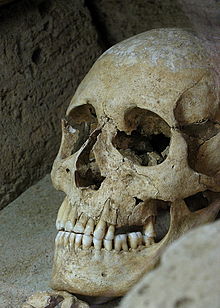Otto von Linn
Otto von Linn (* around 1171; † around 1219) was Lord von Linn (Krefeld) and founder of Linn Castle .
meaning
The Lords of Linn were first mentioned in a document in 1186. However, the oldest bearer of the name was not Otto himself, but his alleged uncle and guardian Gerlachus de Linne. After reaching the age of majority, Otto and his brother, who was not named, sold Linn Castle and all of the associated lands to Philip I of Heinsberg , the Archbishop of Cologne, in 1188 . Otto kept the castle and land as a fief, however, and thus became a liege-man of Phillips. With this documented date, Otto's year of birth can be dated to around 1170–1171. His brother died at a young age. With the financial means thus obtained, Otto fulfilled the requirements for participation in the Third Crusade under Friedrich Barbarossa to the Near East , a duty of honor for a Christian knight of nobility. After his happy return, he used the knowledge he gained there about castle construction and laid the foundation stone for the expansion of his Linn Castle into a fortress in its current form. The polygonal ground plan of the new circular wall and the installation of flanking towers are unmistakably Byzantine influence. Otto von Linn signed a document for the last time in 1218, but this time together with his grown-up son Gerhard as a witness. This fact suggests that Otto was already sick and died soon afterwards. The document of the Abbess von Gerresheim is kept in the main state archive in Düsseldorf .
In 1989 archaeological excavations were carried out on the site of the "Alde Kerk" of Linn. The foundations of the church and the graves of the noble von Linn family were found. The small church was destroyed by a flood in the 14th century and then demolished. At that time it was already in an open field and the site has remained undeveloped to this day. The graves were forgotten. In 1990 Otto von Linn's grave was found here and his bones were exhumed . The grave of his grandfather († around 1150), his mother († around 1185) and his son Gerhard von Linn (* around 1200; † around 1264) were also found. Otto's grave can be viewed today in the Lower Rhine Landscape Museum in the Burg Linn Museum Center . The skeleton was examined by Peter Pieper and R. Piolot at the Institute for Forensic Medicine at Heinrich Heine University in Düsseldorf . No evidence of a systemic disease such as polyarthritis or a possible tumor on Otto's remains could be found. The strong bone structure of the 1.71 meter tall knight suggests that he must have been extremely physically active and muscular during his life. The cause of death can no longer be determined with certainty, but there are signs that point to malnutrition and an infectious disease. Otto suffered from chronic maxillary sinus inflammation , had osteoarthritis of the 4th degree in the left temporomandibular joint, enamel hypoplasia caused by malnutrition , bone inflammation in the upper jaw and the associated loss of the upper molars, a hematoma on the right fibula , inhibited bone growth at a young age and a misalignment of the big toes due to tight shoes. His shins show Harris' lines . These are an indicator of seasonal fluctuations in the food supply. Many symptoms are typical of a beating crusader of the day. The deficiency diseases, for example caused by scurvy , are unusual, however, as nobles of the 12th century usually had a good diet . Medically, the deficiency diseases can almost certainly be dated to the time between the ages of 17 and 20, i.e. the time of his participation in the crusade between 1187 and 1191. In 1190, Barbarossa's exhausted army made its way through Asia Minor, completely exhausted and starving the Anatolian highlands conquered by the Seljuks .
The noble family von Linn died out with the death of Otto's only son, Gerhard von Linn, around 1264.
Web links
| personal data | |
|---|---|
| SURNAME | Otto von Linn |
| BRIEF DESCRIPTION | German crusader and founder of Linn Castle |
| DATE OF BIRTH | around 1171 |
| PLACE OF BIRTH | Linn |
| DATE OF DEATH | around 1219 |
| Place of death | Linn |

